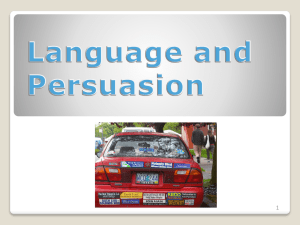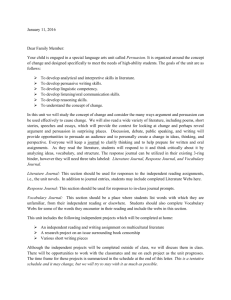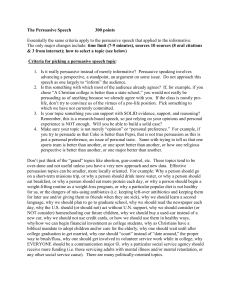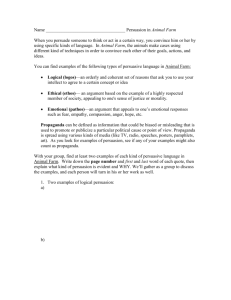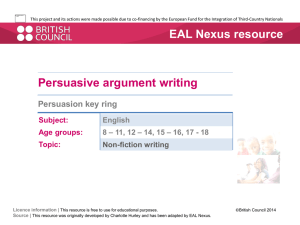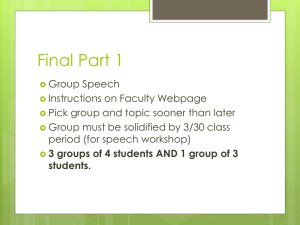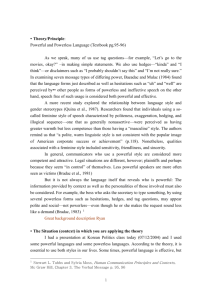Chapter 7: Language and Persuasion
advertisement
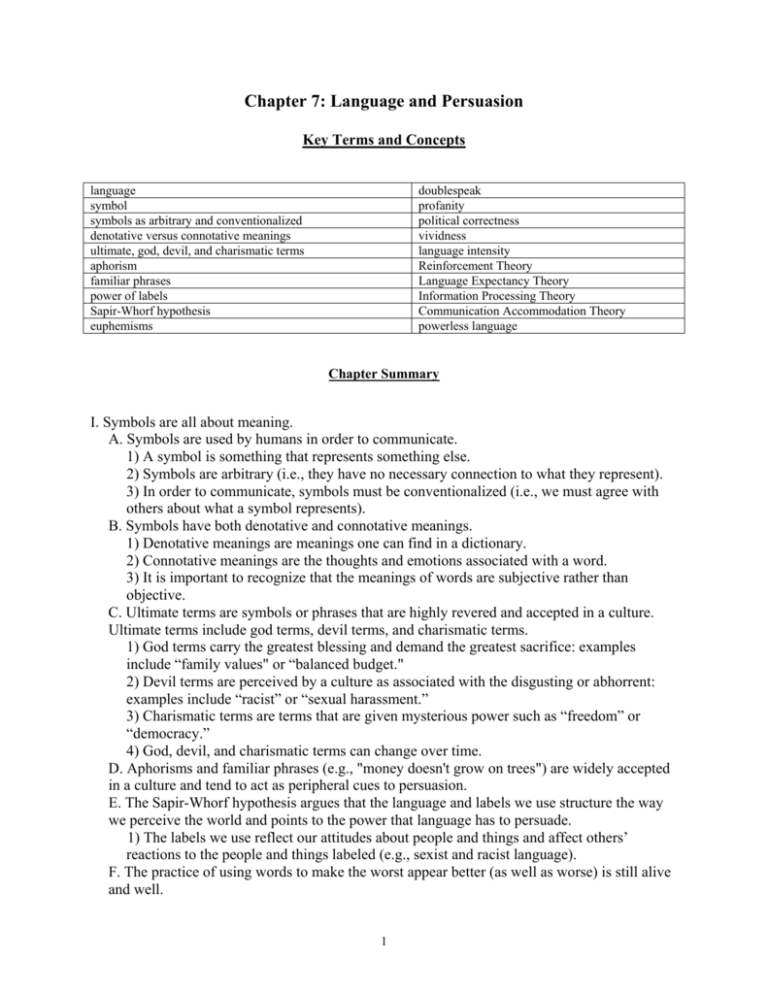
Chapter 7: Language and Persuasion Key Terms and Concepts language symbol symbols as arbitrary and conventionalized denotative versus connotative meanings ultimate, god, devil, and charismatic terms aphorism familiar phrases power of labels Sapir-Whorf hypothesis euphemisms doublespeak profanity political correctness vividness language intensity Reinforcement Theory Language Expectancy Theory Information Processing Theory Communication Accommodation Theory powerless language Chapter Summary I. Symbols are all about meaning. A. Symbols are used by humans in order to communicate. 1) A symbol is something that represents something else. 2) Symbols are arbitrary (i.e., they have no necessary connection to what they represent). 3) In order to communicate, symbols must be conventionalized (i.e., we must agree with others about what a symbol represents). B. Symbols have both denotative and connotative meanings. 1) Denotative meanings are meanings one can find in a dictionary. 2) Connotative meanings are the thoughts and emotions associated with a word. 3) It is important to recognize that the meanings of words are subjective rather than objective. C. Ultimate terms are symbols or phrases that are highly revered and accepted in a culture. Ultimate terms include god terms, devil terms, and charismatic terms. 1) God terms carry the greatest blessing and demand the greatest sacrifice: examples include “family values" or “balanced budget." 2) Devil terms are perceived by a culture as associated with the disgusting or abhorrent: examples include “racist” or “sexual harassment.” 3) Charismatic terms are terms that are given mysterious power such as “freedom” or “democracy.” 4) God, devil, and charismatic terms can change over time. D. Aphorisms and familiar phrases (e.g., "money doesn't grow on trees") are widely accepted in a culture and tend to act as peripheral cues to persuasion. E. The Sapir-Whorf hypothesis argues that the language and labels we use structure the way we perceive the world and points to the power that language has to persuade. 1) The labels we use reflect our attitudes about people and things and affect others’ reactions to the people and things labeled (e.g., sexist and racist language). F. The practice of using words to make the worst appear better (as well as worse) is still alive and well. 1 1) Euphemisms are inoffensive terms used in the place of offensive ones. a. Individuals use less threatening and more respectful words when they are motivated to save face. b. Individuals use euphemisms to be seen as more tasteful and sensitive, thereby saving their own face. 2) Doublespeak refers to the use of ambiguous or evasive language. II. Language intensity, vividness, and offensiveness are closely related variables that affect persuasion between communicators. A. Research suggests that using profanity tends to have a negative effect on perceptions of a speaker’s credibility and persuasiveness, although under the right conditions, using profanity can be persuasive. B. Research suggests that although politically correct language about people with disabilities may lead to perceptions of greater credibility, it may not be perceived as persuasive. 1) Striking a balance between using politically correct language and portraying people with disabilities as victims is key in obtaining donations for people with disabilities. C. Although vivid information captures and holds a person's attention, its persuasive effect depends on what is being vivified and the strength of the arguments being received. D. Several theories attempt to explain when intense language affects the process of persuasion. 1) Reinforcement Theory assumes intense language helps sources when audiences generally agree with the position being advocated and hinders sources when audiences generally disagree with the position being advocated. 2) Language Expectancy Theory suggests that intense language helps or hinders persuasiveness, depending on whether such language violates an audience’s expectations in a positive or negative way. 3) Information Processing Theory suggests that intense language increases persuasion by making a persuadee pay more attention but decreases persuasion if it makes a message seem too discrepant with the persuadee’s position on an issue. 4) Communication Accommodation Theory argues that people who use intense language are more persuaded by intense language. III. Powerless language is language that creates the perception of weakness and/or powerlessness. A. Some research has suggested that using powerless language is associated with being less persuasive. B. Later research suggests that the relationship between persuasion and powerless language depends on additional factors. 1) Polite language and intensifiers, traditionally conceptualized as forms of powerless language, may lead to more persuasion depending on how they are used. 2) When highly credible sources use tag questions, they are perceived as more persuasive, provided that the arguments presented are strong. 3) Males and females are perceived differently when using powerless language. 2
